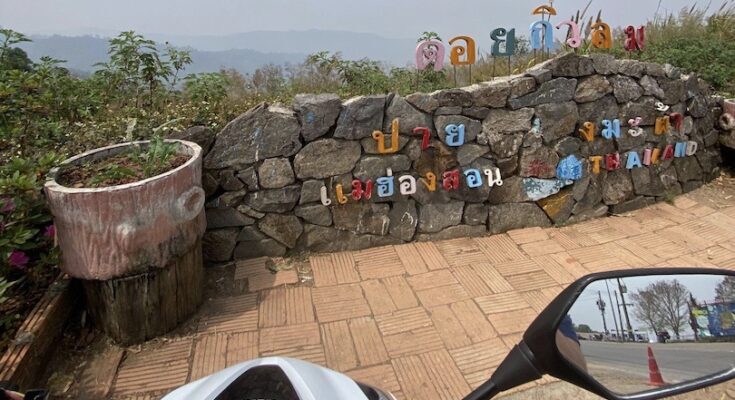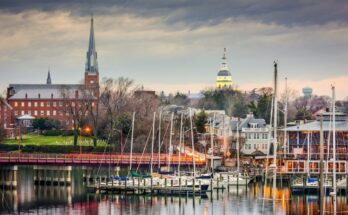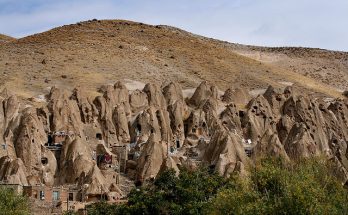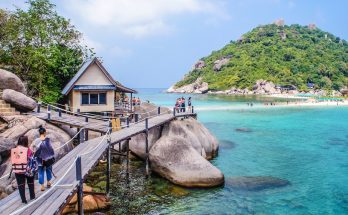Riding a moped on the Mae Hong Son Loop was unlike anything I had ever done before. That feeling of liberation as you zoom around the corners of the mountains in Northern Thailand will stay with you to this day.
The 600 km loop really did exceed all my expectations. It’s like another surprise is waiting behind every one of the 1860 bends on the road. From insanely good food at the Pai night market to the interesting Chinese influence that was evident in Ban Rak Thai.
Keep reading to find out about my journey through the Mae Hong Son Loop.
Day 1 – Chiang Mai to Pai
 Air Diamond Cafe, Kong Gnam View Point
Air Diamond Cafe, Kong Gnam View PointEveryone’s first stop on the loop is at the hippy mountain town of Pai unless you want to do it the other way around and go to Mae Sariang first.
The journey to Pai from Chiang Mai should take you a little over four hours to get there with a stop or two on the way. If you’re driving the loop in a car, it will only take three.
You should leave as early as possible, giving yourself plenty of time for breaks and sightseeing. I left my apartment at 1 PM, with my first stop planned at the Air Diamond Cafe, an old plane transformed into a little coffee shop.
It was so cool; you have to put it on your itinerary; they checked everyone in at a counter before boarding the aircraft and even gave a fake boarding pass. Inside remained the actual plane seating from when it was in service, and the cockpit was open for people to take their pictures. Not to forget the insanely good coffee, which was fuel for the rest of my ride.
With no more time to waste, get back on your bike and hit the open for another hour before stopping at the Kong Gnam View Point, one of the most famous scenic locations on the drive. When I arrived there, it was extremely smoky because it was during Northern Thailand’s notorious burning season. Hopefully, you’ll have a clearer view because seeing the mountain tops scraping the sky is incredible. Even if it’s pretty hazy (which it will be if you go between January and March because that’s when the burning season is), it’s well worth stopping at.
Arriving in Pai

Luckily, I arrived in Pai just before it got dark. Make sure you do, too, because the roads are way too dangerous to drive then.
When you arrive, check into your accommodation immediately and head straight to the town’s bustling night market for a well-needed feed. The vibe here is truly incredible: food vendors screaming at people passing by, the adorable lights dangling above the street, and the ambient music blaring in the background.
You could easily spend the whole night at the night market. Every stall had its own set of plastic-colored chairs for its customers, and many people were sitting around drinking bottles of Chang, a famous Thai beer. Sadly, the next day, you’ll have a four-hour drive to Mae Hong Son the following morning, so that will be off the cards for you unless you’re staying another night.
Day 2 – Pai to Mae Hong Son

Get up as early as possible the following morning because you’ll have another long four-hour drive ahead of you to Mae Hong Son.
The drive is amazing, with so many gorgeous vantage points and plenty of stops where you can see local farmers walking their bulls across the road. I’ll warn you in advance for this part of the drive, though: prepare for many curves and bends. I was a little dizzy by the end of it; I hadn’t expected there to be that many.
Ban Rak Thai

As you arrive in Mae Hong Song, drop your bags and head straight to Ban Rak Thai, a tiny mountain village 129 km on the Thai/Myanmar border. If I were you, I would make sure you give yourself time to do this as it’s the highlight of most people’s trips.
It’s the Chinese influence in Ban Rak Thai is still going strong, with the straw-made Siheyuan-styled homes, locals speaking a unique type of Mandarin, and Yunnan teas sold on every corner.
I chatted with some locals outside a shop and asked them to tell me the story behind the village. They said that after the Chinese Civil War between 1945 and 1949, when the Communists beat the Nationalists, the Nationalists from Yunnan were forced to flee to Ban Rak Thai and start a new life there. Villages like this are quite common in Northern Thailand because of its close proximity to Myanmar, which borders China.
Before you go back to Mae Hong Son, walk up the back hill in the town so you can get a better look at the Siheyuan-styled homes. They really are a feast for the eyes; for a moment, you’ll forget you’re in Thailand and think you’re somewhere in rural China. Local entrepreneurs have built right in the middle of a tea plantation and opened them as guesthouses, which are a great accommodation option if you want to stay there for a night.
Green Curry in Mae Hong Son

There wasn’t much to do in Mae Hong Son when I got back since it was so late, but I did happen to find the cutest little local eatery called the Salween River Restaurant, which served a delicious traditional Green Curry.
This charming, locally owned spot is a typical Thai restaurant built with bamboo sticks and the friendliest staff, who give you a little bow as soon as you walk through the door.
You’ll find plenty of traditional Thai and Burmese dishes on the menu, including Khao Soi, Burmese Green Tea Salad, and Tom Yum Soup. Order the Green Curry with chicken; it’s so yummy and extra spicy, just how it should be. Plus, it’s only 100 Baht, which is nothing to complain about.
Day 3 – Mae Hong Son to Mae Sariang
 Thai-Japanese Friendship Memorial Hall
Thai-Japanese Friendship Memorial HallSince the drive between Mae Hong Son and Mae Sariang is quite short, you’ll have time to squeeze in an attraction halfway through. The woman working in my guesthouse had told me to stop in Khum Yuam to see the Thai-Japanese Friendship Memorial Hall on the way; I highly recommend it.
The Thai-Japanese Friendship Memorial Hall was one of the most fascinating things you’ll see in all of northern Thailand. It’s a museum detailing how Thailand was dragged into WWII by the Japanese; they used the Khun Yuam as a military base to store some of their soldiers and weapons.
Throughout the museum, you’ll find all kinds of interesting artifacts, including the remains of armored trucks and rifles left behind. Some of the Japanese soldiers who worked there even stayed in Khum Yuam after the war and started a family with some of the local ladies.
Mae Sariang

Mae Sariang will be the last stop before taking the last leg of your journey back to Chiang Mai. It’s a quiet little town tucked away along the side of the River Yuam. I didn’t see one tourist here; it had such a local atmosphere.
Make it your mission to go to the Mae La Luang Viewpoint, about an hour outside of town. That area is famous for its photo shots with many twisting roadways that cut through rolling hills. It’s perfect for snagging a shot for your Instagram.
Disappointingly, one of the local farmers was burning his crops as I arrived, so the vista wasn’t very clear to me, but hopefully, you’ll have more luck.
Day 4 – Mae Sariang to Chiang Mai

The final day of your drive is one of the longest, with 197 kilometers to go; the tiredness of this multi-day drive will settle in, so ensure you’re full of energy.
The Mae Sariang to Chiang Mai was no doubt my favorite leg of the trip. You’ll cruise through endless local villages with little kids waving at you, passing mud-colored rivers and dramatic mountain passes, all while the fresh breeze blows you in the face on your scooter.
The moment you reach the highway that leads straight to Chiang Mai, it will feel like another world compared to where you had spent the last three nights. It will take you a while to get used to that level of chaos again after being in the countryside for so long.
Mae Wang National Park

A great stop to end the Mae Hong Son Loop is at Mae Wang National Park.
It covers an area of 119 km² and is home to some fascinating attractions, including the Pha Chor Canyon. The canyon was formed in the past due to the Ping River, which travels through Chiang Mai, changing its course and eroding the rock away. Today, it’s 30 meters deep; if you can go down and walk through it for yourself, do it. It’s no Grand Canyon, but it sure is brilliant to see the remains of the bright yellow rock and the carvings all around it.
You’ll pay an entrance fee into Mae Wang National Park of only 100 Baht (subject to change); the price is lower for locals, which is the same at most attractions in Thailand.
There’s a lot to see around the area of the national park, but some of the attractions aren’t actually within the grounds where you have to pay entry; one of these, in particular, is the popular Mae Wang Waterfall. I suggest you do your research in advance to see what attractions you want to check out and decide if it’s worth your while paying the entry fee.



